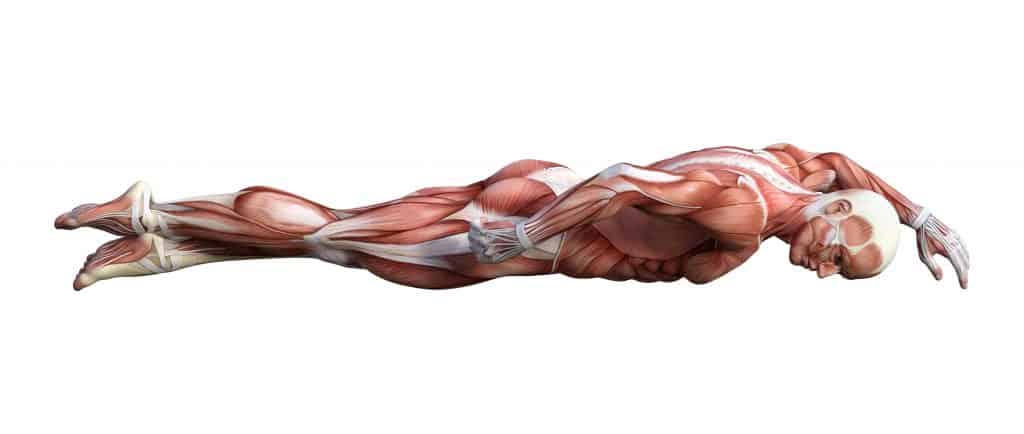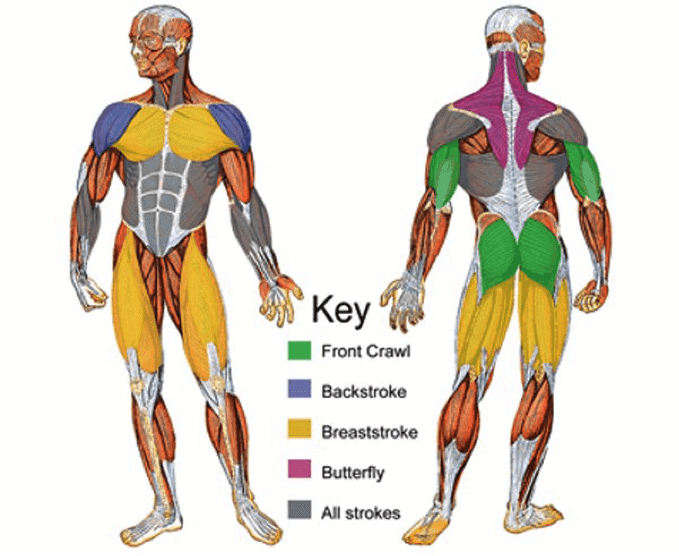
Swimming is a great way to increase your muscular strength and endurance. More commonly viewed as a cardiovascular workout, swimming is still a great way to tone your muscles. You may be wondering what muscles it works. These are the muscles used in swimming.
Muscles Used in Swimming
The muscles used in swimming largely depend on what stroke you are doing in the water. Certain strokes utilize some muscles more than others. However, you’ll start to notice commonalities in all four of the following swimming strokes.
Swimming Breaststroke Muscles
Breaststroke is a great form of exercise. It’s challenging because it requires a lot of rhythmic movement from your arms and legs. Therefore, it works a lot of different muscle groups. So what muscles does breaststroke use?
Breaststroke uses upper body muscles including the latissimus dorsi (back muscles), pectoralis major (chest muscles), biceps and triceps (arm muscles), brachialis, brachioradialis, and deltoids (shoulder muscles). Some of the leg muscles used during breaststroke include glutes (butt muscle), quads (thigh muscles), and your gastroc and soleus (calf muscles). You use a lot to these muscles in day-to-day actions like walking, going up the stairs, and pulling things towards you.
Read our blog to learn more about swimming the breaststroke.
Swimming Freestyle Muscles
The freestyle, or front crawl, swimming stroke uses a lot of arm movement to power you through the water. The flutter kick is also used so some leg muscles are also activated. Therefore, you’ll primarily activate muscles like the triceps, biceps, quadriceps, and hamstrings.
We’ve broken down the stroke into its various movement segments, which are kicking, reach, catch, pull, push, and recovery. Your core is engaged throughout this stroke as well, which is great for toning the abdominals and obliques.
|
Part of Stroke |
Movement |
Muscles Used |
Daily Activities Used |
|
|
Kicking |
Kicking Down | Quadriceps | Thighs | Walking |
| Tibialis Anterior | Shins |
Running |
||
|
Kicking Up |
Hamstrings | Thighs | Stepping up | |
|
Gastrocnemius |
Calves |
Pointing your toes |
||
|
Reach |
Obliques |
Abs |
Twisting your body |
|
| Triceps Brachii | Arms |
Opening a door |
||
| Latissimus Dorsi | Lower Back | Pulling something towards you | ||
|
Rotator Cuff |
Shoulder |
Swinging your arms |
||
|
Catch |
Deltoid |
Shoulder | Raising your hand | |
|
Extensor Digitorum |
Forearm | Pointing your fingers | ||
| Triceps Brachii | Arm |
Shooting a basketball |
||
| Brachioradialis | Arm |
Twisting your arm |
||
|
Pull |
Latissimus Dorsi |
Back | Pull- ups/ Chin-ups | |
|
Brachioradialis |
Arm | Bending at the elbow | ||
| Triceps Brachii | Arm |
Push Ups |
||
| Trapezius | Shoulder |
Shrugging your shoulders |
||
|
Push |
Trapezius |
Upper Back |
Rowing |
|
|
Latissimus Dorsi |
Mid/lower Back | Bent over row | ||
| Deltoids | Shoulder |
Crossing arm over body |
||
|
Rectus Abdominus |
Abs | Crunches | ||
| Obliques | Abs |
Shoveling |
||
|
Recovery |
Deltoid |
Shoulder | Getting a box from a shelf | |
|
Brachioradialis |
Arms | Hitting a tennis ball | ||
| Trapezius | Shoulder |
Elliptical |
||
| Obliques | Abs |
Rotating your body |
||
To learn more about the technique on how to perform the freestyle swimming stroke, check out our blog.

Swimming Backstroke Muscles
The backstroke uses a lot of the same muscles as the freestyle, but it also counters some of those movements. The reverse arm movement activates more of the deltoids (shoulders) and latissimus dorsi (the large muscles that extend across your back). Remember to keep that core engaged as well!
Because the flutter kick is virtually identical as in freestyle, you will activate your glutes, quads, hamstrings, and anterior tibialis (shin muscles) in your legs.
The video below shows that the backstroke is almost like an upside down version of freestyle.
Learn more about the backstroke here.
Swimming Butterfly Muscles
Butterfly is a very physically demanding stroke. To master the butterfly, you need to coordinate the timing of your pull/push arm movements with your dolphin kick (more information on the technique for butterfly can be found here).
This swim stroke utilizes a wide variety of muscles. Some of the more dominant ones include your abdominals, quads, pecs, hamstrings, glutes, deltoids, and lats.
Given all that swimming can do for your muscles, you can see it’s an excellent form of exercise. A summary of muscles used in swimming for the four strokes can be found below.
4 Comments
I love swimming in Sicily is better
What else do you love doing with good old Bill?
I love swimming with my best friend, Bill McCaughey…
Ever since joining Elite, swimming has become my favorite activity. The staff keep the pools in great condition which only adds to my motivation to keep swimming as often as I can. (Like every day! ????????